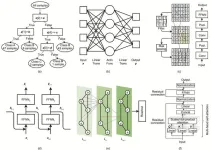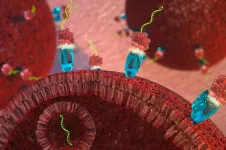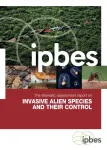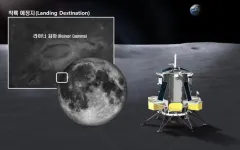(Press-News.org) When it comes to global warming trends, the Arctic is a troubling outlier. The Arctic warms nearly four times faster than the global average, and aerosols play an important role in that warming. Scientists have long known that pollutants from other regions can accumulate in the Arctic atmosphere where they alter atmospheric chemistry, absorb sunlight, and affect local weather patterns, leading to localized warming that melts ice and snow. Sea salt particles dominate aerosol mass concentration, but their production mechanisms and impact on Arctic climate have remained unclear.
Atmospheric scientists led by Jian Wang, director of the Center for Aerosol Science and Engineering (CASE) and professor of energy, environmental & chemical engineering in the McKelvey School of Engineering at Washington University in St. Louis, investigated the production and impact of sea salt aerosols on Arctic warming. Their results, published Sept. 4 in Nature Geoscience, revealed abundant fine sea salt aerosol production from blowing snow in the central Arctic, increasing particle concentration and cloud formation.
“Over the past few decades, scientists have identified ‘Arctic haze’ as the primary source of aerosols in the Arctic during winter and spring. This haze results from the long-range transport of pollutants,” said Xianda Gong, first author on the study and a former postdoctoral researcher in Wang’s lab. “However, our study reveals that local blowing snow, which produces sea salt particles, contributes a more substantial fraction to the total aerosol population in the central Arctic.”
Wang’s team analyzed data collected by the Multidisciplinary drifting Observatory for the Study of Arctic Climate (MOSAiC). Such observations are difficult to obtain – the MOSAiC expedition entailed international collaboration and freezing an icebreaker into the central Arctic ice pack to drift with the sea ice for an entire year – but essential to understanding the full picture of atmospheric conditions in the Arctic.
“The MOSAiC expedition let us observe how aerosols and clouds evolve over the course of a year and led to this discovery,” Wang said. “Sea salt particles in the Arctic atmosphere aren’t surprising, since there are ocean waves breaking that will generate sea salt aerosols. But we expect those particles from the ocean to be pretty large and not very abundant. We found sea salt particles that were much smaller and in higher concentration than expected when there was blowing snow under strong wind conditions,” Wang said.
In the central Arctic, the coldest winter nights are the clearest, when heat from Earth can escape into space unimpeded. Under a cozy blanket of clouds, though, longwave radiation gets trapped and contributes to warming, so any process that leads to increased cloud formation and lingering cloudiness also boosts surface temperatures. Small aerosol particles, including those fine sea salt aerosols produced by blowing snow that Wang’s team discovered, turn out to be very good for cloud formation.
“These sea salt particles can act as cloud condensation nuclei, leading to cloud formation,” Gong said. “Considering the absence of sunlight in the winter and spring Arctic, these clouds have the capacity to trap surface long-wave radiation, thereby significantly warming the Arctic surface.”
Though scientists had not observed this phenomenon before, fine sea salt aerosols from blowing snow have always been part of the Arctic climate system. With this observational confirmation and systematic study, which revealed that sea salt particles produced from blowing snow account for about 30% of total aerosol particles, climate models can now be updated to include the effects of these fine particles.
“Model simulations that don’t include fine sea salt aerosols from blowing snow underestimate aerosol population in the Arctic,” Wang said. “Blowing snow happens regardless of human warming, but we need to include it in our models to better reproduce the current aerosol populations in the Arctic and to project future Arctic aerosol and climate conditions.”
***
Gong X, Zhang J, Croft B, Yang X, Frey MM, Bergner N, Chang RY-W, Creamean J, Kuang C, Martin RV, Ranjithkumar A, Sedlacek AJ, Uin J, Willmes S, Zawadowicz MA, Pierce JR, Shupe MD, Schmale J, Wang J. Artic warming by abundant fine sea salt aerosols from blowing snow. Nature Geoscience, Sept. 4, 2023. DOI: https://doi.org/10.1038/s41561-023-01254-8
***
This work was supported by the U.S. Department of Energy (DOE) Atmospheric System Research Program (DE-SC0020259, DE-SC0021017) and NASA Radiation Sciences Program (80NSSC19K0618). Data used in this manuscript were obtained from the Atmospheric Radiation Measurement (ARM) User Facility, a DOE Office of Science User Facility Managed by the Biological and Environmental Research Program. Data were also produced as part of the international Multidisciplinary drifting Observatory for the Study of Arctic Climate (MOSAiC).
END
Blowing snow contributes to Arctic warming
2023-09-04
ELSE PRESS RELEASES FROM THIS DATE:
Innovative solutions for chemical challenges: Harnessing the potential of machine learning
2023-09-04
In a review published in Engineering, scientists explore the burgeoning field of machine learning (ML) and its applications in chemistry. Titled “Machine Learning for Chemistry: Basics and Applications,” this comprehensive review aims to bridge the gap between chemists and modern ML algorithms, providing insights into the potential of ML in revolutionizing chemical research.
Over the past decade, ML and artificial intelligence (AI) have made remarkable strides, bringing us closer to the realization of intelligent machines. The advent of deep learning methods and enhanced data storage capabilities has played a pivotal role in this progress. ML has already demonstrated success ...
Uncovering thalassemia diversity in southern china through next-generation sequencing
2023-09-04
Around 5.2% of the global population carries abnormal hemoglobin genes [1]. Each year, 300,000 to 500,000 children are born with severe hemoglobinopathies worldwide, with approximately 80% of these cases occurring in developing countries [2]. Thalassemia is the most common hereditary hemoglobinopathy and occurs in 4.4 out of every 10,000 live births [3]. It is prevalent in Mediterranean coastal areas, Africa, the Middle East, Southeast Asia, and southern China.
A previous study indicated that Ganzhou, the southernmost city in Jiangxi province, had a thalassemia prevalence ...
NYU Abu Dhabi researchers develop novel tumor-targeting nanospheres with the potential to dramatically improve light-based cancer diagnosis and treatment
2023-09-04
Abu Dhabi, UAE (September 4, 2023) – In a breakthrough in cancer therapeutics, a team of researchers at the Magzoub Biophysics Lab at NYU Abu Dhabi (NYUAD) has made a significant advance in light-based therapies – biocompatible and biodegradable tumor-targeting nanospheres that combine tumor detection and monitoring with potent, light-triggered cancer therapy to dramatically increase the efficacy of existing light-based approaches.
Non-invasive, light-based therapies, photodynamic therapy (PDT) and photothermal therapy (PTT) have the potential to be safe and effective alternatives to conventional cancer treatments, which are beset by a ...
Ecosystem footprint concept and its potential applications in environmental management
2023-09-04
Traditionally, the impact of human activity on an ecosystem has lacked context when planning restorative ecosystem mitigation and management strategies. Multiple human activities over time and space, the resilience of a particular ecosystem, and the stress caused by many individual or related, overlapping activities that generate cumulative effects may affect the overall "ecosystem response footprint," or ability of an ecosystem to adapt and change to human activity.
A team of marine scientists reviewed the most recent perspectives on ecological footprints to rigorously define the term "ecosystem response footprint" as the ...
First-in-class targeted microRNA therapy slows cancer tumor growth
2023-09-04
WEST LAFAYETTE, Ind. – A new cancer therapy developed by Purdue University researchers attacks tumors by tricking cancer cells into absorbing a snippet of RNA that naturally blocks cell division. As reported today in Oncogene, tumors treated with the new therapy did not increase in size over the course of a 21-day study, while untreated tumors tripled in size over the same time period.
Cancer can begin almost anywhere in the human body. It is characterized by cells that divide uncontrollably and that may be able to ignore signals to ...
Invasive Alien Species Pose Major Global Threats to Nature, Economies, Food Security and Human Health: IPBES report
2023-09-04
The severe global threat posed by invasive alien species is underappreciated, underestimated, and often unacknowledged. According to a major new report by the Intergovernmental Platform on Biodiversity and Ecosystem Services (IPBES), more than 37,000 alien species have been introduced by many human activities to regions and biomes around the world. This conservative estimate is now rising at unprecedented rates. More than 3,500 of these are harmful invasive alien species – seriously threatening nature, nature’s contributions to people and good quality of life. Too often ignored until it is too late, invasive alien species are a ...
Korean Scientific payload for observing the lunar space environment begins its transfer to the US for the scheduled 2024 launch
2023-09-04
The Ministry of Science and ICT (Minister Jong-Ho Lee, hereinafter referred to as 'MSIT') and the Korea Astronomy and Space Science Institute (Director Young-Deuk Park, hereinafter referred to as 'KASI') announced the beginning of the transfer of the lunar space environment monitor, 'LUSEM'(Lunar Space Environment Monitor) that will be aboard United States’ unmanned lunar lander in 2024, has began on September 4th.
LUSEM is a payload developed by the Korea Astronomy and Space Science Institute (KASI) in participation with the U.S. NASA's CLPS(Commercial Lunar Payload Services) initiative ...
IOP Publishing appoints Dr. David Gevaux as Chief Editor of Reports on Progress in Physics
2023-09-04
IOP Publishing (IOPP) has appointed Dr. David Gevaux as the first Chief Editor of Reports on Progress in Physics. Taking up the post from the 4th of September, Dr. Gevaux will lead on ambitious plans for the journal, as its scope expands to include groundbreaking new research content alongside the authoritative reviews for which it is well known across all areas of physics.
Working closely with Professor Subir Sachdev, the Editor in Chief of Reports on Progress in Physics, Dr. Gevaux will champion the editorial ...
New study uncovers the Causes of the Qing Dynasty's Collapse
2023-09-04
The Qing Dynasty in China, after over 250 years, crumbled in 1912. Led by the Complexity Science Hub (CSH), an international research team has pinpointed key reasons behind the collapse, revealing parallels to modern instability and offering vital lessons for the future.
China is considered today to be the world's largest economy (in terms of PPP). However, this position is not new. In 1820, China's economy already held the top spot, accounting for 32.9% of the global GDP. In the interim, there was a period of decline followed by a resurgence. In 1912, after over 250 years in power, the Qing Dynasty collapsed despite being considerably wealthier at the time ...
New genes and natural toxins offer hope for cancer patients unresponsive to chemotherapy
2023-09-04
Scientists from Queen Mary University of London have discovered two new genes that cause head and neck cancer patients to be resistant to chemotherapy, and that silencing either gene can make cancer cells previously unresponsive to chemotherapy subsequently respond to it.
The two genes discovered actively ‘work’ in most human cancer types, meaning the findings could potentially extend to other cancers with elevated levels of the genes.
The researchers also looked through a chemical library, commonly used for drug discovery, and found two substances that could target the two genes specifically and make resistant cancer cells almost 30 times more sensitive to ...







